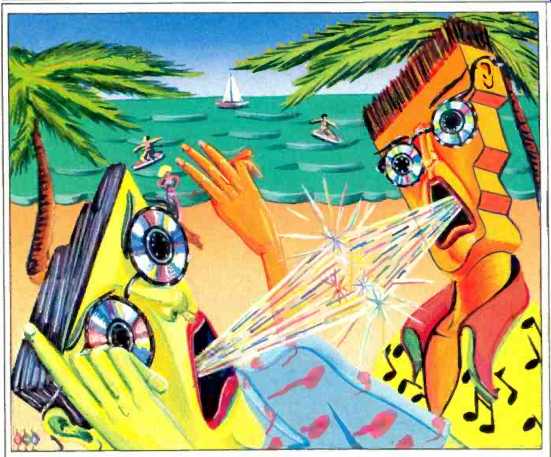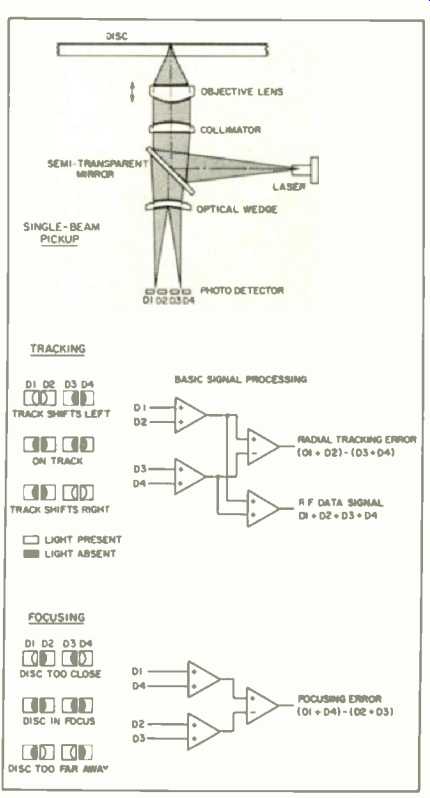
AURAL ARGUMENTS
Contrary to the sensational ac counts presented on a certain television show, life here in Miami is generally pretty quiet. This is particularly true at the University of Miami, where the quest for scholarship enhances the air of tranquility. As Professor of Music Engineering, my biggest worry is keeping dry during tropical downpours.
Thus I was surprised when a fight recently broke out between two of my top students. It was a heated exchange, with the kind of intensity saved for very serious questions in deed. But instead of shouts of "tastes great!" and "less filling!" I heard cries of "one-beam!" and "three-beam!" Compact Disc player pickup design had provoked yet another altercation.
No matter where you go, a Compact Disc is a Compact Disc. Whether manufactured in Langenhagen, Terre Haute, or Tokyo, all are 120 mm wide, with a spiral pit track that is 0.6 µm wide and 1.6 um away from the adjacent track. That's the CD Standard. But when it comes to hardware to read those pits, it's every man(ufacturer) for himself. Differences of opinion on the best way to play CDs have created considerable engineering diversity.
That diversity starts right at the pick up, where a disc's pit/land transitions are optically read by a laser beam, later to be converted into an r.f. (radio frequency) signal and then demodulated to extract audio and control data.
The pickup must maintain focusing and tracking even under adverse playing conditions, such as when dirt, shock, or vibration are present.
We have four methods for tracking the pit spiral: One-beam push-pull, one-beam differential phase detection (DPD), one-beam h.f. (high-frequency) wobble, and three-beam. Three techniques are available for generating a focusing signal: Cylindrical lens using astigmatic focusing, Foucault focusing, and critical-angle focusing.
Of course, any pickup must simultaneously perform both tracking and focusing, so a complete design must in corporate techniques for both. Fortunately, we are spared the task of analyzing all the possible combinations, because when the focusing and tracking mechanisms are linked, two pickup designs stand out from the rest: One-beam push-pull tracking with Foucault focusing, and three-beam tracking with astigmatic focusing.
Both of these designs have been used in commercial players, with the Europeans generally favoring the former and the Japanese the latter. Thus, the battle lines for one-beam versus three-beam designs have been drawn.
Only in portable players have these rivals generally agreed on pickup de sign-one-beam, in this case, primarily because it saves space.
The optical components of a one-beam design are shown in Fig. 1, along with the photodiode array used to generate tracking and focusing signals as well as the data signal. A solid state diode generates the laser beam which strikes the semi-transparent mirror; a collimator and objective lens focus the beam on the disc's reflective pit-track surface. As the track flies by, the pits and land areas of the data stream reflect the laser beam with varying intensity; the land is highly reflective, whereas the pit (perceived as a bump from underneath) cancels and disperses the light and is therefore less reflective.
On its return path, some of the reflected laser light passes through the semi-transparent mirror and strikes an optical wedge. This splits the light into two beams which are adjusted to strike an array of four horizontally arranged photodiodes, D1, D2, D3, and D4. The outputs of all the photodiodes are summed to provide the data signal, which is demodulated to yield audio and control data.
The diodes also generate error signals for tracking and focusing. As the pickup wanders from the pit track, it creates an intensity difference be tween the two split beams. Either photodiode pair D1/D2 or D3/D4 generates a stronger signal from the in creased laser light; the difference be tween the pairs produces an error signal which is used to move the pick up back on track.
When focus varies, the focal point of the system is shifted, and the split beams draw closer together or farther apart, thanks to an effect first observed by J. B. L. Foucault in the 1850s. The difference between diode pairs D1/D4 and D2/D3 forms a focus-error signal which is used to move the objective lens back into focus. Of course, in practice, the four photodiodes simultaneously perform all three tasks of data reading, tracking. and focusing.
A three-beam pickup design is shown in Fig. 2. Two side beams are added; these are used exclusively for tracking, while the center beam takes care of focusing and data retrieval. In addition, the actual focusing technique uses astigmatic instead of Foucault focusing. The primary laser beam is split into three beams by a diffraction grating; two of these beams are directed to either side of the pit track. As the pick up wanders off the track, the side beam encounters more land and thus receives more reflected light, while the beam striking the pit track receives less. The intensity difference in the beams striking photodiodes E and F creates a tracking-error signal, which moves the pickup back on track.
Meanwhile, the center beam passes through a cylindrical lens and is directed to photodiodes A, B, C, and D. (The secondary tracking beams to E and F do not pass through this lens.) As the distance between the objective lens and the pit track varies, the focal point of the system changes, projected by the cylindrical lens changes shape because of the astigmatic properties of cylindrical lenses.
The shape of the image on the photodiode array generates the focus-error signal.
In the final analysis. both designs perform the same functions. But the engineering advantages seem to favor the one-beam design. The optics in a three-beam system are inherently more complicated: there are at least five components (objective lens, collimator, grating, cylindrical lens, and beam splitter) compared to the four components in a one-beam design (objective lens, collimator, wedge, and semi-transparent mirror). In addition, the three-beam design requires sever al factory adjustments, including secondary-beam and diffraction-grating alignment, whereas the one-beam de sign needs only a single adjustment, of the photodiode assembly's horizontal position.
A three-beam design is also more complex from a mechanical viewpoint.
A one-beam system can be mounted on a single pivoted arm, which de scribes an arc across the disc surface: since there is only one moving part, wear is minimal and reliability is high. A three-beam pickup requires linear movement because the three beams must stay in a fixed position relative to the pit track. The three-beam pickup is thus mounted in a sled which moves radially across the disc. (A one-beam pickup could also be mounted in a sled.) The sled is often driven by a lead screw: the pitch of the screw's thread is a compromise between the fine thread required for normal tracking (at 35 mm per hour) and the coarse thread needed for fast forward and re verse (at. perhaps, 35 mm per second). Often, a coarse thread is used to achieve fast disc access, and a movable mirror is inserted in the laser's path to deflect the beam quickly to handle small differences such as track eccentricity.
On balance, it appears that the one beam is the better design, because it is simpler. (When one prominent manufacturer switched from a one-beam to a three-beam pickup in its CD players, I asked the chief design engineer why.
He replied that his engineering division firmly preferred a one-beam design, but the marketing division felt that consumers perceived three beams as being better than one. Engineering was forced to go along, strictly for marketing reasons.) In terms of traditional specifications such as frequency response, channel separation, etc., there should be no sonic difference between one- and three-beam designs. How ever, it is possible that one design has the edge in tracking and focusing, which would be manifested in reduced need for error correction and concealment. In the long run, that adds up to fewer audible errors. Ultimately, though, performance must be evaluated on a player-by-player basis, bearing in mind that a one-beam design might have a built-in advantage. When you're shopping for a player, it's certainly one more thing to think about.
Uh-oh-looks like another fight has broken out! I can hear shouts of "analog filtering!" and "digital filtering!" from the stairwell.

Fig. 1--Layout, tracking, and focusing of a single-beam CD player pickup.

Fig. 2--Layout, tracking, and focusing of a three-beam CD player pickup.
(adapted from Audio magazine, Jul. 1986)
Also see:
Dr. Thomas Stockham on the Future of Digital Recording (Feb. 1980)
= = = =